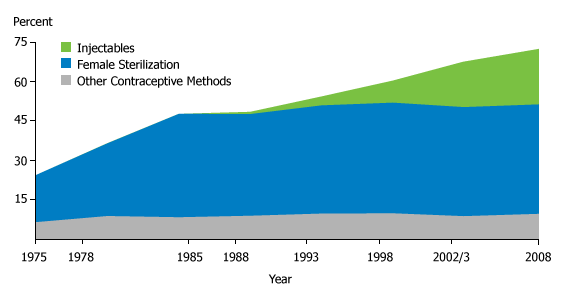
El Salvador Survey Shows Lower Fertility, Increased Contraceptive Use
Women of childbearing age in El Salvador are having fewer children and using more family planning, with a recent increase in the use of injectable contraceptives. A 2008 family planning survey by the El Salvador Ministry of Health found that fertility dropped 60 percent in the last 30 years, from 6.3 lifetime births per woman in the mid-1970s to 2.5 in the 2003-2008 period.1
Higher Fertility in Rural Areas, Among Less Educated
Women in rural areas have about one child more than those in urban areas: 3.0 compared with 2.1, but the rural/urban fertility gap has narrowed. In a 1998 survey, rural women reported nearly two more children than urban women, on average.
The fertility difference among wealthy and poor women has also diminished, although it is still substantial. Women in the wealthiest one-fifth of households had 1.6 lifetime births, less than half the number among women in the poorest one-fifth (3.7). But just five years earlier, a survey reported the average fertility among the wealthiest and poorest women spanned a much wider range: from 1.6 children to 5.0 children.
Similar differences were documented among women in the highest and lowest educational levels. Women without formal education had more than twice the number of children as women with 10 or more years of education (1.8), or in the highest wealth quintile (1.6). But again, the gap is lower than it was even five years earlier.
Heavy Reliance on Female Sterilization
Much of this long-term fertility decline resulted from major increases in contraceptive use. The percentage of women of childbearing age using contraception increased from 47 percent in 1988 to 73 percent in 2008, led by large increases in the use of female sterilization.
Beginning in the late 1970s, El Salvadoran women began to undergo tubal ligation in large numbers. The percentage of women of childbearing age who had been sterilized rose from barely 10 percent in 1975 to 31 percent by 1985. It has been near that level for the last 23 years. El Salvador has one of the highest sterilization rates in Latin America and the Caribbean, exceeded only by Brazil, the Dominican Republic, and Puerto Rico.2 Only a few Asian countries, most notably India and China, have female sterilization rates above this level. In the United States, about 21 percent of women of childbearing age have been sterilized.
The reliance on sterilization among young women in El Salvador is striking: Nearly one-fourth of women under age 30 had been sterilized in 2004. Research shows that women often regret having been sterilized at a young age, and many seek another operation to reverse it.3 Sterilized women interviewed in a rural El Salvador community in 2005 said they had chosen the procedure because it was readily available and because they feared the side effects and contraceptive failures they had heard about with other methods. Sterilization was offered to women around the time of childbirth, when they were in the hospital or visiting health clinics for prenatal and postnatal care, and it was readily accepted.
A study from the U.S. Centers for Disease Control and Prevention found that sterilization is not foolproof as previously thought, and that pregnancies in sterilized women—although rare—are most common among women under age 30 and run a higher risk of complications.4 The copper intrauterine device (IUD) actually has a lower failure rate than tubal ligation—suggesting that younger women could be well protected from an unplanned pregnancy by a temporary method, without potential for regret or desire for another, often unsuccessful, operation to reverse it.
Contraceptive Use in El Salvador, 1975-2008
 Source:/strong> Ministerio de Salud El Salvador et al., Encuesta Nacional de Salud Familiar: FESAL-2008 (2009), accessed at www.fesal.org.sv, on Oct. 5, 2010.
Source:/strong> Ministerio de Salud El Salvador et al., Encuesta Nacional de Salud Familiar: FESAL-2008 (2009), accessed at www.fesal.org.sv, on Oct. 5, 2010.
Increase in Injectable Hormone Use
The 2008 family planning survey documented that female sterilization is still the most common method of contraception in El Salvador, but it also showed a growing use of temporary methods, especially injectable hormones that women must receive every 12 weeks. The percentage relying on injectables rose from less than 2 percent of users in 1988 to 31 percent in 2008 (see figure). Other modern methods such as oral contraceptives, the condom, and IUDs, attract far fewer women.
El Salvador’s impressive fertility decline was initially driven by female sterilization. The most recent survey shows not only an impressive narrowing in the fertility differences among rich and poor, urban and rural, but also a much greater acceptance of temporary methods of birth control.
References
- Ministerio de Salud El Salvador et al., Encuesta Nacional de Salud Familiar: FESAL-2008 (2009), accessed at www.fesal.org.sv, on Oct. 5, 2010.
- Donna Clifton, Toshiko Kaneda, and Lori Ashford, Family Planning Worldwide: 2008 Data Sheet (Washington, DC: Population Reference Bureau, 2008), accessed at www.prb.org, on Oct. 5, 2010.
- Miriam L. Cremer et al., “Deciding Between Sterilization and Alternatives in Rural El Salvador,” Medscape Journal of Medicine 10, no. 8 (2008): 183, accessed at www.medscape.com/viewarticle/575893_3, on Sept. 30, 2010.
- Family Health International, “Female Sterilization Safe, Very Effective,” Network 18, no. 1 (1997), accessed at www.fhi.org/en/RH/Pubs/Network/v18_1/NW181ch2.htm, on Oct. 5, 2010.
